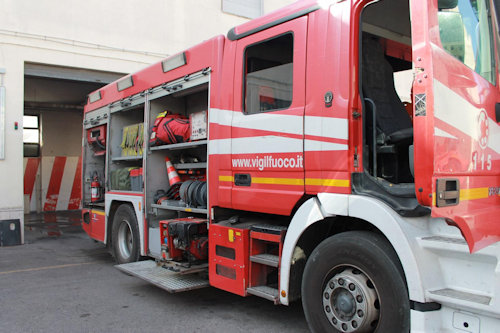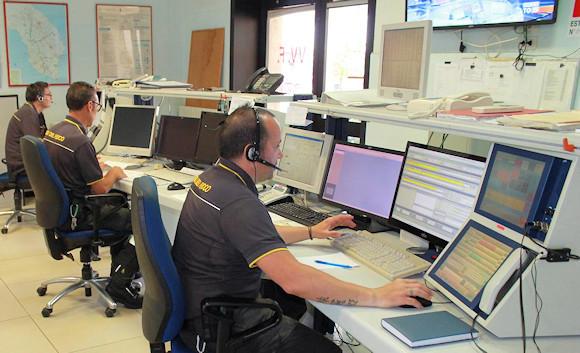Among fires, emergencies, environmental alarms, job accidents, gas leaks, and sick leave, no breaks, 7giorni on 7 provide security and provide public relief to citizens, in a capillary manner, throughout the country. Firefighters never have the certainty of the end of the service shift: they may find themselves working 24 on 24 without restraint, knowing that their lives depend on the lives of other people. They run where the emergency calls with special vehicles, helicopters and cars.
I went to the 6.30 to get to the barracks, at the Provincial Command I assigned, a little in advance. To welcome me there is the vigilant coordinator and national instructor of the Cynophilic nucleus for Puglia and Abruzzo, Oronzo Passabì. A firm handshake, a smile and a "welcome" are enough to make me feel immediately at ease. After entry, to the left of the maneuvering castle in wood, it is known that different means are absent. The megaphone is announced the turn of the year. The day shift runs from 8 to 20, while the night shift goes from 20 to 8. The number of firefighters engaged in the various shifts changes in the various provincial commands and detachments of Italy.

I attend the meeting, the firefighters listen to the head of duty on duty: at the roll call, each one will confirm his presence and will be assigned to a specific vehicle or to a specific activity. No firefighter always performs the same job. In the various shifts, the presence of the "guard officer on duty" is also provided: he is responsible for the rescue at the provincial level when an intervention requires not only the use of more teams but also a technical evaluation to understand whether to continue the activities with the procedure started or address it with different techniques, means and methods.
The firefighters assigned to the Operations Room always start a few minutes before their "operational" colleagues: this is where the calls from the citizens who make up 115 arrive. The operators filter incoming signals and manage priorities based on the request for help , the means and the men available. Sometimes it also works by "friend phone" - says one of the operators - for many people. Especially in the summer, we try in some way to listen and give comfort.
The first need for firefighters is the speed of intervention. The first team (the number of teams varies from city to city, of course) always goes first to places where human lives are at risk. Each team consists of 5 firefighters: the driver (head of the vehicle), the chief, a watchdog coordinator, and two permanent firefighters who handle the intervention.
The most well-known firefighting activity that characterizes them on national territory is the urgent technical assistance: they intervene with APS (Auto Pump Tank), autoscale, buses, special vehicles and high-qualified nuclei or specialized cores.
 The first team has APS as a means of intervention: a universal medium that can intervene in any type of intervention (from road accident to cat recovery, from flooding to door opening, etc). Made up of various compartments that open and close by shutter: they contain the "loading" material needed for daily operations. Usually right, there is the material to be used for road accidents and various types of fires, to the left we find much of the tools to be used during flooding but not only.
The first team has APS as a means of intervention: a universal medium that can intervene in any type of intervention (from road accident to cat recovery, from flooding to door opening, etc). Made up of various compartments that open and close by shutter: they contain the "loading" material needed for daily operations. Usually right, there is the material to be used for road accidents and various types of fires, to the left we find much of the tools to be used during flooding but not only.
From fire extinguishers to the insulating shear, from the generator to the headlight column for night lighting, from the chainsaw to snow chains ... And then hoses of various sizes (UNI 45 and 70) and type (STORZ) to be connected to the pump that is located in the rear of the vehicle, to send water (or foam) during a fire, up to the electric fan to disperse the smoke in a saturated environment.
In the APS cabin there is the space for the personal intervention bag. All firefighters as well as the school services uniform have their own PPE (personal protective equipment including a rescue uniform - firefighting, summer or winter, a raincoat and boots) that they wear as soon as they get on the vehicle for the rescue operation. As soon as you get on board, time leaves no room for fear. Each member of the team knows that it takes courage and professionalism, otherwise it “leaves the skin”.
 The means used by firefighters are numerous: autoscale whose length varies from 20 m to 37 m (extending), pump autobots, cogwheels, NBCR (nuclear, bacteriological, chemical and radioactive) wagon for specialist core operations, wagons foam, amphibians, rescue aid, and earth moving means.
The means used by firefighters are numerous: autoscale whose length varies from 20 m to 37 m (extending), pump autobots, cogwheels, NBCR (nuclear, bacteriological, chemical and radioactive) wagon for specialist core operations, wagons foam, amphibians, rescue aid, and earth moving means.
Among the logistic vehicles, each provincial command has the “module” peasant campagnole: they are associated with the first departure or with the pump truck during the summer period for a quick intervention in roadside bush fires. Off-road vehicles are used to transport support personnel for more complex interventions.
Except for the special means, each provincial command and the various detachments possess the "ordinary" rescue vehicles. Among the basic means there is the AF / UCL (Advanced Local Crisis Unit) or also called PCA (Advanced Command Post). It has the function of a mobile operating room where it is possible to coordinate the human resources of the fire brigade and of the other police who are at the site of the intervention, with a radio apparatus that allows communication with the various teams intervened. If properly equipped, it also allows management of satellite communication. It has been used several times during seismic events, the disappearance of people, flooding, setting up refugee camps, etc.
training
The training of men and women of the National Body of Fire it is continuous throughout the service: from entry for recruitment to the passage of qualification, to specialization and updating. The courses are organized in various central and regional structures. The training facilities are the Higher Fire Protection Institute (ISA), at the Central Fire Prevention School of Capannelle (SCA) and the Operational Training School of Montelibretti, in Rome. The latter has training courses and numerous simulation systems where extremely realistic scenarios are recreated. These include a gallery, a subway and the Fire House, a building where an apartment has been reconstructed inside.
Each Provincial Command organizes bodies of various kinds: from the issuance of VF ministerial licenses to those for SAF (Speleo-Alpino-Fluvial), TPSS (First Aid), USAR (search for people scattered under rubble) to courses TAS (Topography Applied to Rescue).
Specialist staff is formed in specific Centers in Rome. All activities are coordinated by the Central Training Directorate and Regional Directions.

The selection
To carry out the profession of firefighter, you must participate in a public competition for men and women up to the 37 years. Having passed the written tests, the physical requirements that each candidate must possess are fundamental, as there is no distinction between men and women. Tests are specific and require high physical effort because future firefighters must be ready to use and wear special equipment and face emergency situations. It is no coincidence if in the effort room the firefighter is "stressed" by simulating a physical fatigue training to climb stairs, move a weight, make a walk along with the self-breath.
Physical and psychological stress is characteristic of the operating conditions in which firefighters work.
In addition to the firefighters on permanent service, there are also firefighters at the various provincial commands auxiliary and firefighters discontinuous. For both of them there is no employment relationship with the administration but are recorded in specific lists established by the commands belonging to and are required to serve for a period of 14 days according to the territorial needs. When they are in service, they perform all the functions of a permanent fireman. However, they are entitled to a remuneration for the service provided. The auxiliary are part of the staff dismissed after lend service and have offered their willingness to continue the relationship with the body. Watchmen discontinuous instead they followed a specific course at the various commands to which they belong - with a favorable outcome - and they faced various physical tests of varying difficulty (from the use of the equipment, to the Italian scale up to the smoke chamber).
 Most of the firefighters with whom I chatted while waiting told me that, despite doing good, the pain for a person who cannot be saved from death is never forgotten. However, a small gesture, meeting a child or a joke from a colleague is enough to bring back the smile ...
Most of the firefighters with whom I chatted while waiting told me that, despite doing good, the pain for a person who cannot be saved from death is never forgotten. However, a small gesture, meeting a child or a joke from a colleague is enough to bring back the smile ...
It's time to leave the barracks. The instructor Oronzo still has a few minutes with him Lycia, his labrador. Also Lycia it is part of the Cinofila Puglia Unit. It is in the appropriate "transport".
There is a slight wind of tramontana that attenuates the heat, the site planned for training in a rubble field is out of town ...
(Continued)
Also read: "Fire Brigade, Ancient History"
Also read: "Core Cowboys Firefighters: training in a rubble field"












